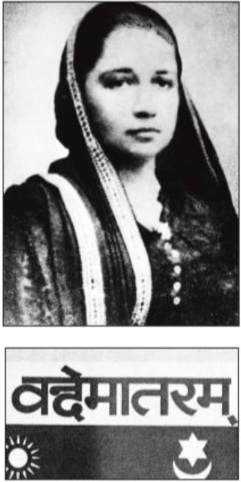Madame Bhikaji Cama
This is a collection of articles archived for the excellence of their content. |
Hoisting of Indian flag
Vaibhav Purandare TNN, August 14, 2022: The Times of India

From: Vaibhav Purandare TNN, August 14, 2022: The Times of India
One of India’s most spirited revolutionaries during the freedom movement Madame Bhikaji Cama unfurled the first version of the Indian national flag at the International Socialist Congress at Stuttgart in Germany on August 22, 1907. The flag was believed to have been designed by her “jointly with (Vinayak Damodar) Savarkar”, according to her biographer Khorshed Adi Sethna; both were part of a group of Indians fighting for the country’s liberation from beyond its borders. It was green, saffron and red in colour, with the words Vande Mataram inscribed on it.
“This flag,” she said to people gathered at the Congress, “is of India’s independence. Behold, it is born. ” And she appealed “to lovers of freedom all over the world to cooperate… in freeing from slavery one-fifth of the human race. ” Describing her impact on the global gathering, German newspaper Leipziger Zeitung wrote that when Cama in her “shimmering silken garments… entered the rostrum” and asked the Congress to help the people oppressed by Britain and displayed the “silken tricolour, the banner of the oppressed, the cheers of the International would not end. ” It was 22 years after her defiant act that the Indian National Congress adopted the tricolour as its flag (in a modified form) at its Lahore session in 1929.
Born into a prosperous Parsi family in Mumbai (then Bombay) in September 1861, Bhikaji Cama, daughter of businessman Sorabji Framji Patel and Jijibai Patel, could have spent all her life in luxury. But after her marriage to Rustom Cama, son of noted orientalist Khurshedji Rustomji Cama, she realised the two of them thought very differently on issues: she was public-spirited and keen to see India freed from the clutches of the Raj, while the husband believed in the benevolence of British rule. They eventually separated, and in 1902, her health completely broken, Bhikaji went to England for recovery. There, she got in touch with Shyamji Krishna Varma, who ran ‘India House,’ a centre for nationalist-minded Indians in London, and a band of Indian patriots who were carrying out anti-colonial activities and campaigns on British soil. British socialist HM Hyndman, with whom the Indian revolutionaries abroad interacted regularly, recommended the names of Bhikaji and her fellow revolutionary Sardar Rana for the Stuttgart Congress. Initially Bhikaji had worked with Dadabhai Naoroji in London, but as the years passed, she had found the assertive stand of Lokmanya Tilak and Aurobindo Ghose more acceptable and had started delivering speeches against the Raj at Hyde Park. But ‘India House’ was the place she related to the most, and its young revolutionary hero Savarkar became her favourite. Savarkar and Cama, along with the other revolutionaries, built relations with revolutionaries and freedom-loving groups from other countries. Inevitably the Raj looked askance at what was going on in its own capital, and Cama in 1909 left for Paris, a safer ground, to continue activities from there. Savarkar, who was being pursued by Scotland Yard, found shelter in her Paris home but the following year, he returned to London and was promptly arrested by the Raj and sent to ‘Kaala Paani’. His sentencing prompted Bhikaji Cama, who saw him as the biggest hope for the Indian cause, to write to fellow patriot M P T Acharya that “the great master, desh bandhu Savarkar” had paid the price for his patriotism.
As per Cama’s biographer, the tricolour she unfurled in 1907 had “a line of eight stars on the top green stripe, emblematic of the (then) eight provinces of India; the words Vande Mataram were embroidered in Sanskrit” on the saffron band in the centre, and on red stripe at the bottom there was, near the side of the staff, an orb and on the outer side, a crescent.
Despite Savarkar’s arrest, Cama carried on with her work in France, though she was interned for three years by the French authorities during the First World War. Gradually the revolutionaries abroad struggled to keep their movement afloat, and after Tilak’s death in 1920, Mahatma Gandhi took the freedom movement in a new direction.
After 35 years in exile, and once again broken down in health, Cama was allowed to return to India in 1936. She had lived in a boarding house in France for long and had lost most of the money she had taken with her abroad: she had sold the jewellery her mother had given her to fund the activities of Indian anticolonial agitators and had spent much of her money also to organise the defence of Savarkar in the courts. Soon after she reached Mumbai, she had to be taken to the Parsee General Hospital owing to her ill-health. There, she stayed for eight months and passed away on August 16, 1936, in near-total obscurity. A real trailblazer, she received momentary recognition in free India in 1962 when a road in Mumbai — the one on which Mantralaya stands — was named after her. And then she was promptly forgotten again.